
How Maxwell's Equations are Defined for Electrostatics and EEVibes
Lecture notes on Maxwell's equations in integral form in free space, Ampere's law, Gauss' law for electric field and magnetic field, conservation of charge, and Lorentz force law.
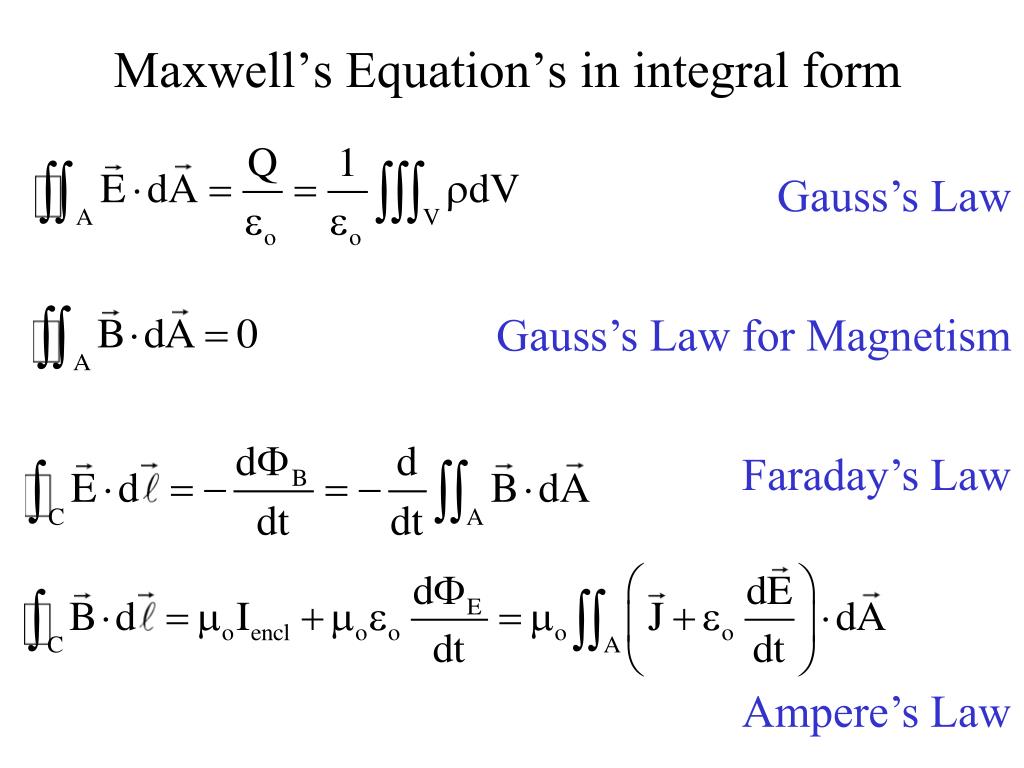
PPT Maxwell’s Equations PowerPoint Presentation, free download ID1322316
Maxwell's equations are a set of four differential equations that form the theoretical basis for describing classical electromagnetism: Gauss's law: Electric charges produce an electric field. The electric flux across a closed surface is proportional to the charge enclosed. Gauss's law for magnetism: There are no magnetic monopoles. The magnetic flux across a closed surface is zero.

Maxwell equation in integral form YouTube
Maxwell's equations, four equations that, together, form a complete description of the production and interrelation of electric and magnetic fields. The physicist James Clerk Maxwell, in the 19th century, based his description of electromagnetic fields on these four equations, which express experimental laws.

PPT Maxwell’s Equations PowerPoint Presentation, free download ID1460697
15.11: Maxwell's Equations in Potential Form. In their usual form, Maxwell's equations for an isotropic medium, written in terms of the fields, are. together with D = ϵ E and B = μ H, we obtain for the first Maxwell equation, after some vector calculus and algebra, (15.11.7) ★ ∇ 2 V + ∂ ∂ t ( div A) = − ρ ϵ. For the second.
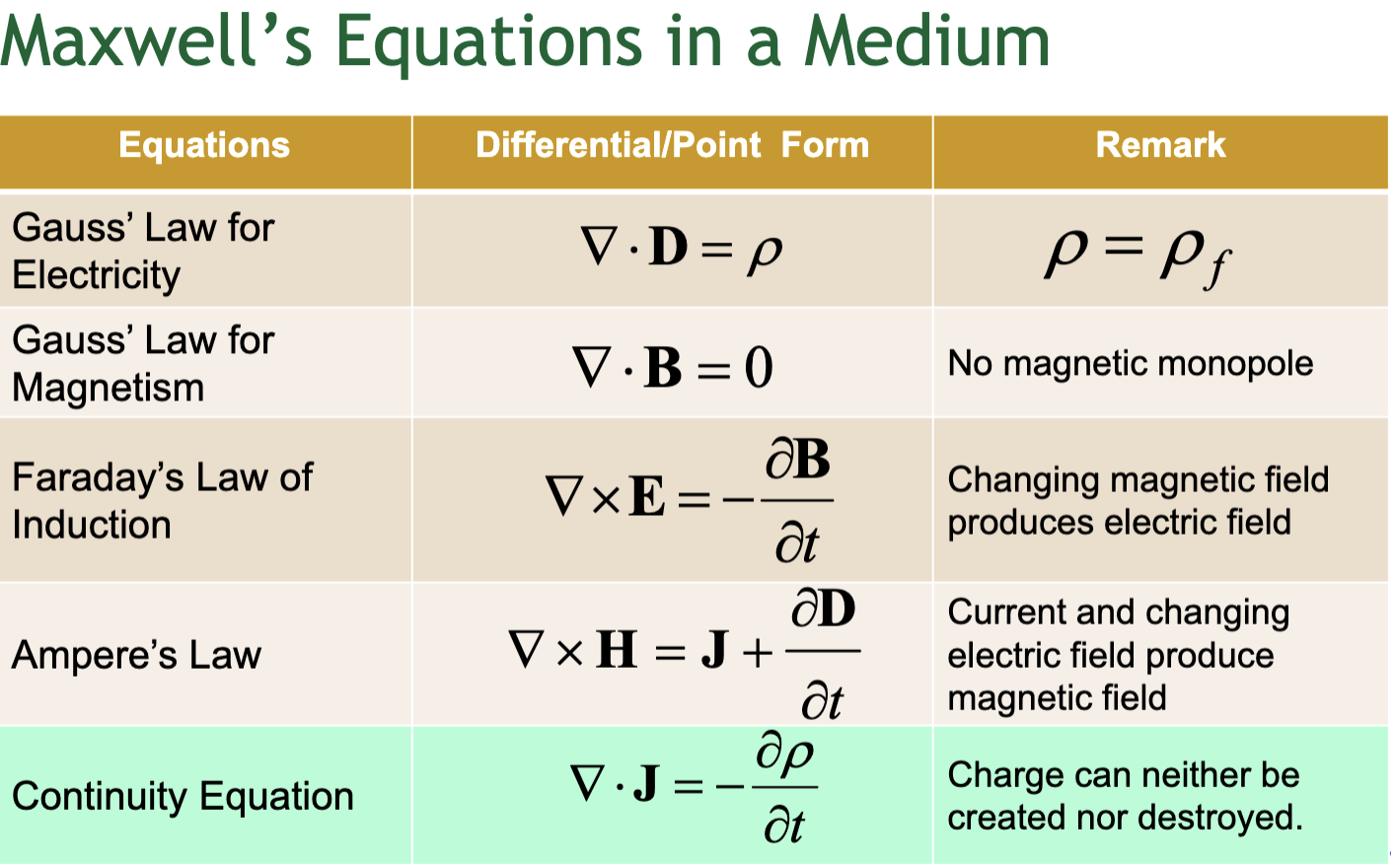
Solved Maxwell's Equations in a Medium Equations Integral
Maxwell Third Equation. Statement: Time-varying magnetic field will always produce an electric field. Maxwell's 3rd equation is derived from Faraday's laws of Electromagnetic Induction.It states that "Whenever there are n-turns of conducting coil in a closed path placed in a time-varying magnetic field, an alternating electromotive force gets induced in each coil."

Maxwell's Equations in Integral Form Poster Physics Posters
Introduction, Maxwell's Equations 5 In 1980s, Bell's theorem (by John Steward Bell) [25] was experimentally veri ed in favor of the Copenhagen school of quantum interpretation (led by Niel Bohr) [26].
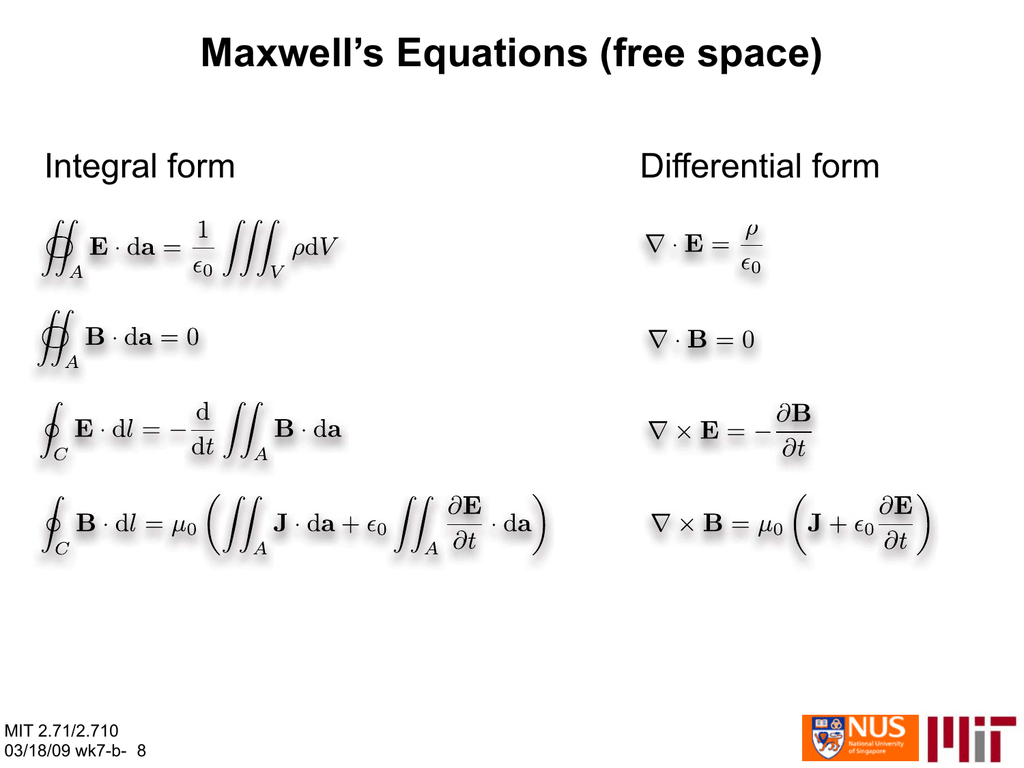
Maxwell’s Equations (free space) Integral form Differential form MIT 2.71/2.710
Maxwell's equations, or Maxwell-Heaviside equations, are a set of coupled partial differential equations that, together with the Lorentz force law, form the foundation of classical electromagnetism, classical optics, electric and magnetic circuits. The equations provide a mathematical model for electric, optical, and radio technologies, such as power generation, electric motors, wireless.

"Maxwell's Equations Integral Form" Poster by PhysicsThisWeek Redbubble
Application of Vector Calculus. To this point, we have derived three fundamental theorems of advanced calculus: Green's theorem on circulation and vorticity in two dimensions,

Maxwell's Equations Integral Form Poster Personalized prints, Equations, Custom
It is referred to as the polarization charge density.1 On a microscopic scale, the electric field slightly distorts the atomic orbitals in the material (see Fig. 1.2). On a macroscopic scale, this results in an accumulation of charges at the surface of the material (see Fig. 1.3). The net charge density inside the material remains zero.
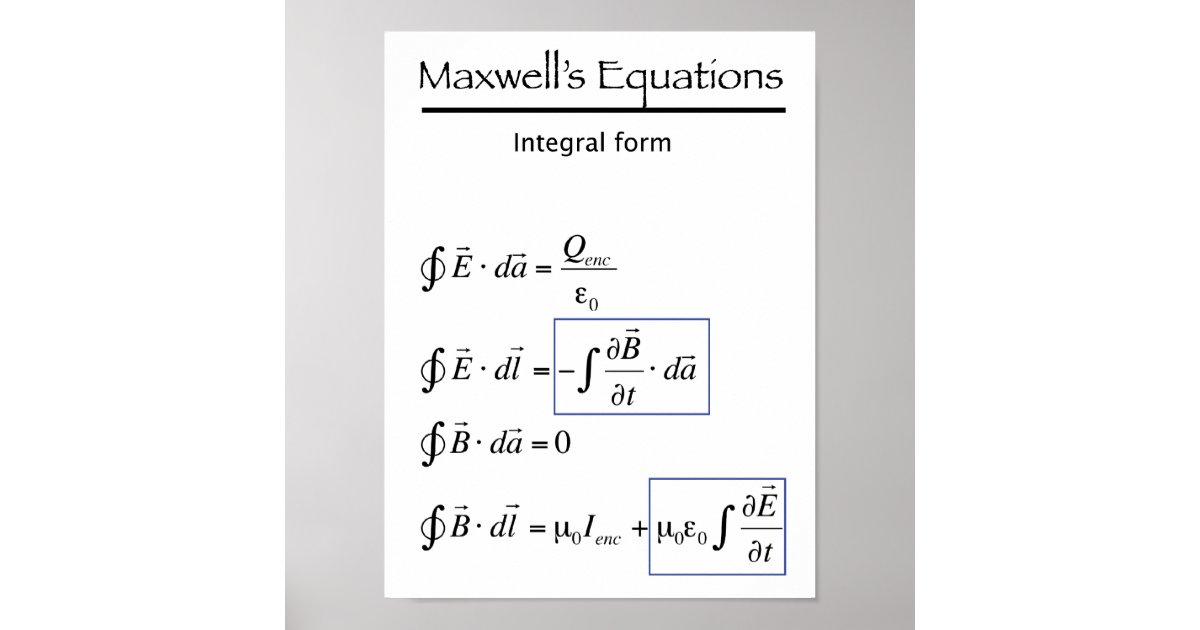
Maxwell's Equations Integral Form Poster Zazzle
In equation ( 1.1 ), is the induced electric field (in units of V m −1 ), is the magnetic flux density, or magnetic inductance (in units of Tesla, or kg s −1 A −1 ), the left-hand side integral is along a closed path, while the right-hand side is over an area . The integral on the right-hand side denotes the magnetic flux, where is the.
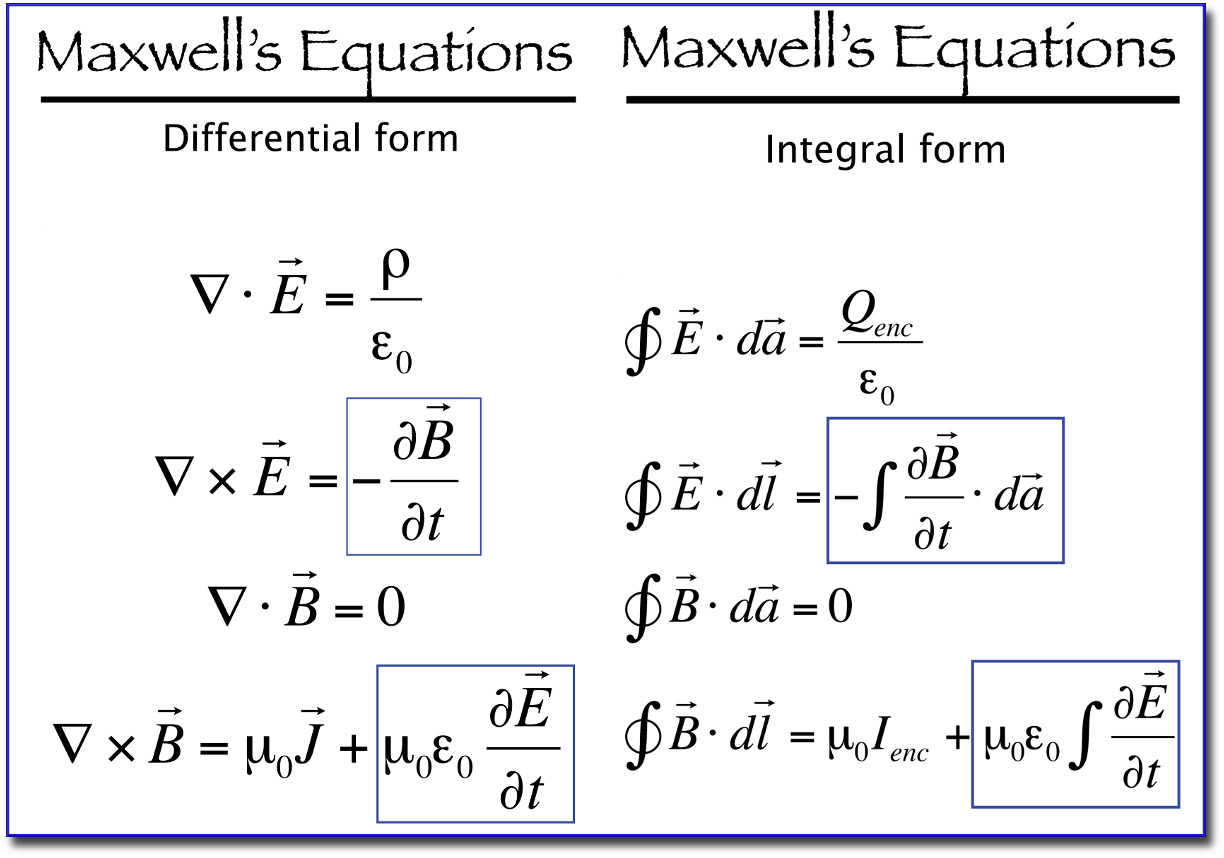
Origini delle equazioni di Maxwell tra genio e follia
Chapter 1 Introduction 1.1 Maxwell's Equations Electromagnetic wave propagation is described by particular equations relating ve vector elds E, D, H, B, J and the scalar eld ˆ, where E and D denote the electric eld
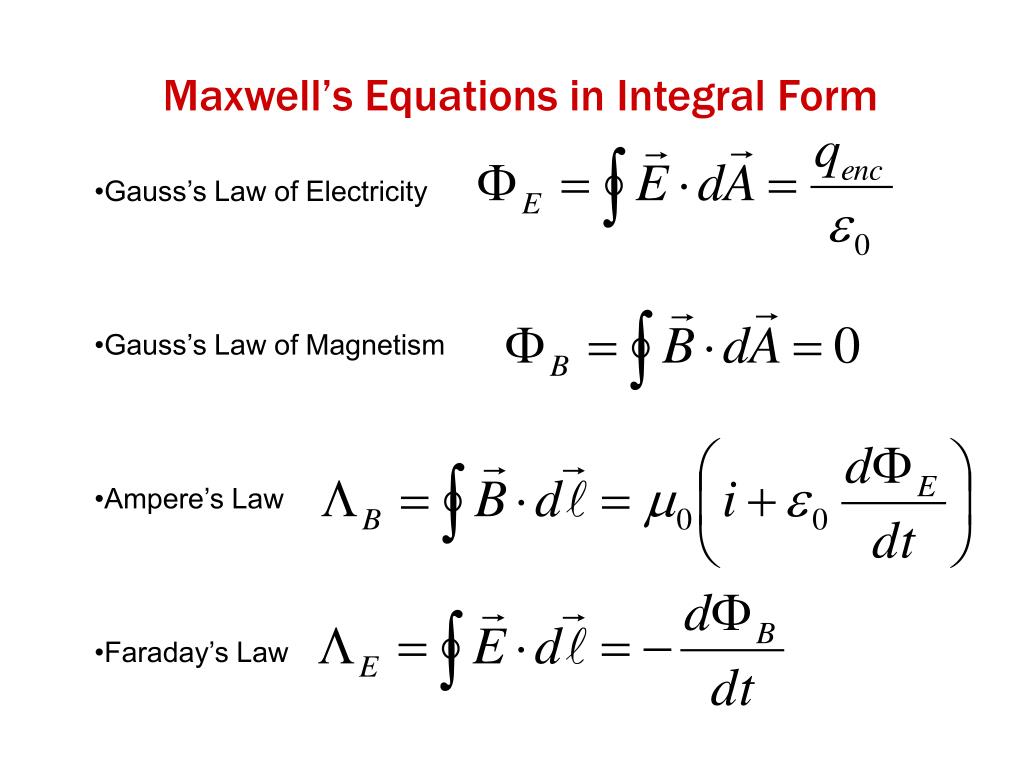
PPT Class 31 PowerPoint Presentation, free download ID5167550
78 Chapter 2 Maxwell's Equations in Integral Form E (a) (b) E 1 l 1 l 2 l 3 l j l n a 1 a 2 a 3 a j a n E 2 E 3 E j E B A B A C FIGURE 2.1 For evaluating the total amount of work done in moving a test charge along a path C from point A to point B in a region of electric field. moving the charge to another point an infinitesimal distance away.To find the total

"Maxwell's Equations Integral Form" Poster by PhysicsThisWeek Redbubble
Maxwell's equations represent one of the most elegant and concise ways to state the fundamentals of electricity and magnetism. From them one can develop most of the working relationships in the field. Because of their concise statement, they embody a high level of mathematical sophistication and are therefore not generally introduced in an.

PPT Maxwell’s equations PowerPoint Presentation, free download ID1461021
Learn the basics of Maxwell's equations, the fundamental laws of electromagnetism, in this lecture from the US Particle Accelerator School. You will understand the sources and properties of electromagnetic fields, the differential and integral forms of the equations, and the concepts of phase and group velocity.

Solved Maxwell's Equations for Steady Electric and
40 Chapter 2 Maxwell's Equations in Integral Form For convenience, we shall divide the path into ten segments having equal widths along the x direction, as shown in Figure 2.2(a).We shall number the segments 1, 2, 3, 10.The coordi- nates of the starting and ending points of the jth segment are as shown in Figure 2.2(b).The elec- tric field at the start of the jth segment is given by
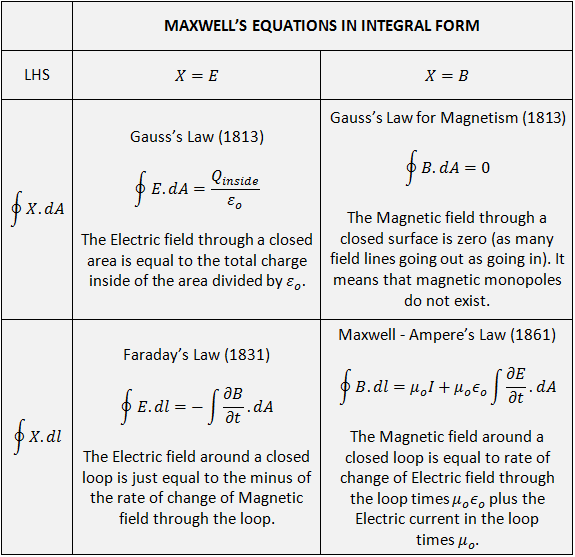
Maxwell’s Equations in Integral Form RAYmaps
from Office of Academic Technologies on Vimeo.. 9.10 Maxwell's Equations Integral Form. Let's recall the fundamental laws that we have introduced throughout the semester. First, Gauss's law for the electric field which was E dot dA, integrated over a closed surface S is equal to the net charge enclosed inside of the volume surrounded by this closed surface divided permittivity of free.